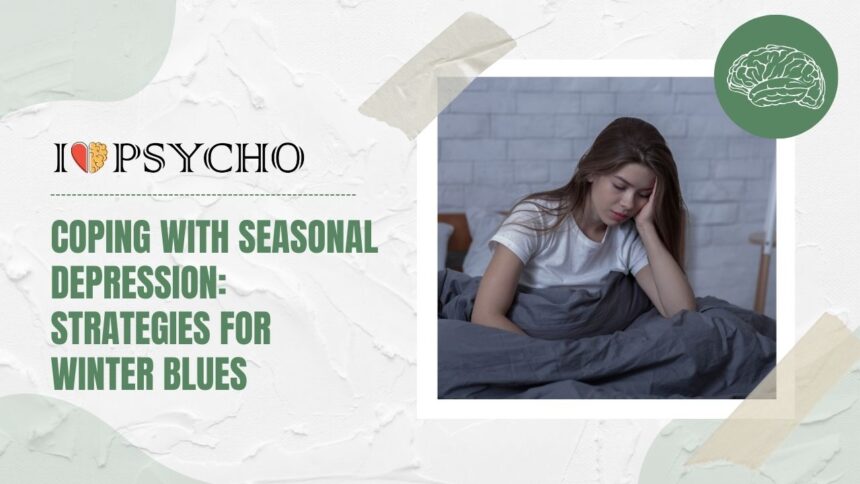As the days grow shorter and the chill in the air becomes more pronounced, many of us may find ourselves feeling a bit off-kilter. It’s that time of year when seasonal depression can creep in, casting a shadow over our usual sunny dispositions. But fear not! In this blog post, we’ll explore strategies to help you beat those winter blues and embrace the season with a renewed sense of vitality. So grab a cozy blanket and let’s dive into coping with seasonal depression together!
Understanding Seasonal Depression
Seasonal depression, also known as Seasonal Affective Disorder (SAD), is a type of mood disorder that typically occurs during the colder months when daylight hours are shorter. It’s more than just feeling a little blue; it can impact your daily life and overall well-being. Those affected by seasonal depression may experience symptoms such as low energy levels, changes in sleep patterns, irritability, and difficulty concentrating.
The lack of sunlight in the winter months plays a significant role in triggering seasonal depression for many individuals. Sunlight exposure helps regulate our internal body clock and the production of serotonin – a neurotransmitter that affects mood. When sunlight is scarce, these processes can be disrupted, leading to feelings of sadness and lethargy.
Understanding the nuances of seasonal depression can help you better navigate its challenges and seek appropriate support when needed. It’s essential to recognize the signs early on so that you can take proactive steps to manage your mental health during the winter season.
Common Symptoms of Seasonal Affective Disorder (SAD)
As the days grow shorter and colder, many people find themselves experiencing symptoms of Seasonal Affective Disorder (SAD). These can manifest as feelings of sadness, hopelessness, or irritability that seem to coincide with the changing seasons. It’s not uncommon to also notice changes in sleep patterns, appetite, and energy levels during this time.
People with SAD may struggle to concentrate or feel unmotivated to engage in activities they once enjoyed. The winter blues can take a toll on both mental and physical well-being. Some individuals may even withdraw from social interactions and isolate themselves more than usual.
It’s essential to recognize these signs early on and seek support if needed. Understanding that you’re not alone in feeling this way can be a comforting realization amidst the challenges brought about by seasonal depression.
Causes and Triggers of Seasonal Depression
Seasonal depression, also known as Seasonal Affective Disorder (SAD), can be triggered by various factors. One primary cause is the decrease in sunlight during the winter months, which disrupts our internal body clock and affects mood-regulating neurotransmitters like serotonin.
Another factor contributing to seasonal depression is the imbalance of melatonin levels due to reduced daylight exposure. When melatonin production increases, it can lead to feelings of lethargy and sadness.
Moreover, colder temperatures may discourage outdoor activities and exercise, impacting overall well-being. The lack of physical activity can further exacerbate symptoms of seasonal depression.
Additionally, genetic predisposition plays a role in some individuals experiencing seasonal depression more severely than others. Those with a family history of mental health conditions may be at a higher risk for developing SAD during the winter months.
Understanding these causes and triggers can help individuals recognize potential signs of seasonal depression early on and seek appropriate coping strategies before symptoms worsen.
Coping Strategies for Winter Blues
As the winter months approach, many individuals find themselves grappling with the dreaded winter blues. The lack of sunlight and colder temperatures can often take a toll on our mental well-being. However, there are various coping strategies that can help alleviate the symptoms of seasonal depression.
One effective method to combat winter blues is light therapy. By exposing yourself to bright light for a specified amount of time each day, you can mimic natural sunlight and regulate your body’s internal clock.
Exercise is another powerful tool in fighting off the winter blues. Physical activity releases endorphins, which are known as “feel-good” hormones that can enhance your mood and energy levels.
Incorporating a healthy diet into your routine can also make a significant difference in managing seasonal depression. Consuming foods rich in vitamins and minerals can support overall brain health and improve your mood.
Moreover, socializing and staying connected with loved ones can provide much-needed emotional support during challenging times. Reaching out to friends or family members for companionship or simply having meaningful conversations can uplift your spirits.
Remember, it’s essential to explore these coping strategies and find what works best for you personally when combating winter blues.
A. Light Therapy
When the winter blues start to weigh you down, light therapy can be a game-changer. This treatment involves sitting in front of a lightbox that mimics natural sunlight. The bright light helps regulate your body’s internal clock and boosts mood-enhancing neurotransmitters.
Using a lightbox for around 30 minutes each morning can make a significant difference in managing seasonal depression symptoms. It’s important to position the lightbox correctly, usually at eye level and about 16-24 inches away from your face.
Make sure to consult with a healthcare provider before starting light therapy to determine the appropriate intensity and duration for your specific needs. Consistency is key with this therapy, so try to establish a routine that works best for you.
Light therapy may not work instantly, but over time, many individuals find it to be an effective tool in combating the winter blues. Give it some time and stay committed to see if it brings some sunshine back into your life!
B. Exercise
During the winter months, finding the motivation to exercise can be challenging. However, physical activity is a powerful tool in combating seasonal depression. Whether it’s going for a brisk walk outside, trying out yoga at home, or hitting the gym, moving your body releases endorphins that can boost your mood.
Exercise doesn’t have to be intense – even light activities like stretching or dancing can make a difference. Setting small and achievable goals for yourself can help you stay on track and feel accomplished. Remember that consistency is key; even short bursts of exercise throughout the day can add up.
If outdoor workouts are not appealing due to cold weather, there are plenty of indoor options available online. From workout videos to virtual fitness classes, there are countless resources to keep you active from the comfort of your own home. So lace up those sneakers and get moving!
C. Eating a Healthy Diet
During the winter months, it’s important to pay attention to what we eat as it can have a significant impact on our mood and overall well-being. Consuming a healthy diet rich in fruits, vegetables, whole grains, and lean proteins can help combat seasonal depression.
Foods high in omega-3 fatty acids like salmon, walnuts, and flaxseeds can support brain health and reduce inflammation linked to mood disorders. Incorporating complex carbohydrates such as brown rice or quinoa can help regulate serotonin levels, also known as our “feel-good” hormone.
Avoiding excessive caffeine and sugary treats is essential since they may lead to energy crashes and worsen feelings of anxiety or lethargy. Instead, opt for natural sources of energy like fresh fruit or nuts for sustained vitality throughout the day.
Remember that nourishing your body with wholesome foods not only fuels you physically but also contributes to a more balanced emotional state during the darker days of winter.
D. Socializing and Staying Connected
During the winter months, it can be easy to isolate yourself and withdraw from social interactions. However, staying connected with friends and loved ones is crucial for managing seasonal depression. Make an effort to plan regular get-togethers or virtual hangouts to maintain your relationships.
Engaging in activities with others can help boost your mood and provide a sense of belonging. Whether it’s grabbing a cup of coffee, going for a walk, or simply chatting on the phone, connecting with others can make a significant difference in how you feel.
Joining support groups or attending social events can also offer opportunities to meet new people who understand what you’re going through. Sharing experiences and receiving support from others dealing with seasonal depression can be empowering and comforting.
Remember that reaching out for help when needed is not a sign of weakness but rather a brave step towards self-care. Don’t hesitate to lean on your support system during challenging times – they are there to uplift you and offer encouragement.
Seeking Professional Help
If you find that coping with seasonal depression alone is becoming overwhelming, it may be time to seek professional help. A mental health professional can provide you with the support and guidance needed to navigate through this challenging time. They are trained to help individuals manage their symptoms and develop effective coping strategies.
Therapy sessions can offer a safe space for you to express your feelings and explore the root causes of your seasonal depression. Through therapy, you can learn new ways to cope with stress, regulate your emotions, and improve your overall well-being.
In some cases, medication may also be recommended by a healthcare provider to help alleviate symptoms of seasonal affective disorder. It’s essential to consult with a qualified professional who can assess your individual needs and create a personalized treatment plan tailored specifically for you.
Remember that seeking professional help is not a sign of weakness but rather a proactive step towards taking care of your mental health. If you’re struggling, reaching out to a therapist or psychiatrist could make all the difference in managing your seasonal depression effectively.
Tips for Loved Ones to Support Someone with Seasonal Depression
Supporting a loved one dealing with seasonal depression can be challenging, but your presence and understanding mean more than you may realize. First and foremost, listen without judgment. Let them express their feelings openly, without feeling invalidated. Offer your support by simply being there for them.
Encourage healthy habits gently; suggest going for a walk together or cooking a nutritious meal. Small gestures like these can make a big difference in their mood and overall well-being. Additionally, remind them that seeking professional help is not a sign of weakness but rather an essential step towards healing.
Be patient and understanding as they navigate through their emotions. Sometimes all they need is someone to lean on during tough times. Educate yourself about seasonal depression to better understand what your loved one is going through – knowledge truly is power when it comes to providing meaningful support.
Conclusion
Coping with seasonal depression can be challenging, but it is important to remember that you are not alone in this journey. By understanding the symptoms, causes, and triggers of seasonal affective disorder (SAD), you can better equip yourself with coping strategies to navigate through the winter blues.
From light therapy and exercise to maintaining a healthy diet and staying connected with loved ones, there are various ways to manage seasonal depression. Remember that seeking professional help is always an option if you feel overwhelmed or unable to cope on your own.
For those supporting someone with seasonal depression, offering empathy, patience, and encouragement can make a significant difference in their mental health journey. Together, we can work towards creating a supportive environment where individuals battling seasonal depression feel understood and supported.
Remember, it’s okay not to be okay sometimes. What matters most is reaching out for help when needed and taking proactive steps towards healing and self-care. Stay strong, stay positive, and remember that brighter days are ahead.









